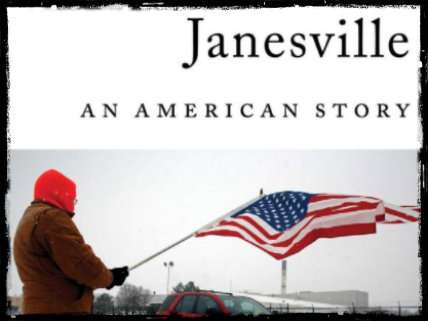New Book Offers Bleak Look at Paul Ryan's Hometown
In 2008, Obama told GM factory workers in Janesville, Wisconsin, that the plant would "be here for another 100 years." It has since closed, leaving thousands unemployed.

Barack Obama showed up at the General Motors factory in Janesville, Wisconsin, during the 2008 presidential campaign and proclaimed, "I believe that, if our government is there to support you and give you the assistance you need to retool and make this transition, that this plant will be here for another hundred years."
Instead the plant closed, leaving thousands of its workers and those at related businesses unemployed.
Nor is Obama the only politician to intersect with the Janesville story. It's Paul Ryan's hometown. Ryan is Speaker of the House and was the Republican vice presidential candidate in 2012. His father lost the tip of his thumb to a piece of machinery in the plant, working summers during law school.
A reporter at The Washington Post, Amy Goldstein, tells this tale in her new book, Janesville: An American Story.
It's almost unbelievably grim.
Auto worker wages, once $28 an hour, have declined to $14 for new hires—$10 for some workers working for "suppliers" on the same factory floor.
Janesville, which you might have imagined as a wholesome, prosperous, middle class American city—something out of a Land's End catalog—turns out to have 400 homeless children, some of whom have been abandoned by their parents.
A United Auto Workers local that a decade ago had 7,000 active members now has 438, with 4,900 retirees.
Another large employer in the city, Parker Pen, was sold three times. The final buyer shut the factory and laid off the staff, but first paid longtime workers to fly to Mexico and train people there to do their old jobs.
One former auto industry employee goes back to school to become a prison guard, then commits suicide after cheating on her husband with an inmate.
Others become "GM gypsies," leaving their families behind for days at a time to commute to far-away GM jobs in other states.
Some families can't qualify for health care at a free clinic because the food stamps they are receiving push their income over the limit.
One family was turned away from a food pantry because their teenager, working three after-school jobs, earned too much for the family to qualify for help. The line at the food pantry starts forming outside two hours before it opens.
These are the sort of disgruntled Americans, facing economic anxiety, who elected Trump, right? Goldstein points out, though, that while Trump did carry Wisconsin's electoral votes, Janesville itself went for Hillary Clinton in the 2016 election, as it went for Obama in 2012, notwithstanding Ryan's presence on the 2012 ticket.
What's the remedy?
Not education or job training, necessarily: Goldstein reports that laid-off workers who went back to school at the local technical college ended up worse off, financially, than those who did not.
Someone who understands Washington better than I do once explained to me that if you really want to understand a politician you need to know their home district. That was the genius of Michael Barone's classic Almanac of American Politics: it didn't just tell you about the congressman and where he or she went to college, it told you about who the big employers were, and what countries the great-grandparents of the voters in the district had come from.
Ryan comes off as a bit remote in Goldstein's telling, more absorbed in the long-term details of the federal budget than in the up-close trauma of Janesville families. But if you want to understand his motivations when it comes to bringing manufacturing back to the American heartland, finding more effective ways to combat poverty, and strengthening economic growth, you can do a lot worse than to start in Janesville.
President Trump was talking about urban crime when he spoke of "carnage" in his inaugural address. But he could have been talking about how the layoffs ripped through Janesville families.
The economic picture is different in more prosperous quarters, like, say, Silicon Valley, or the Washington, D.C. suburbs. But places like Janesville, even if their unemployment rates have recovered, are nonetheless hurting.
Goldstein doesn't really get into whether Janesville's ills are primarily cyclical—something that will heal eventually as the economy improves—or structural, a kind of "new normal" of slow wage growth resulting from globalization or the decline of unions.
If the causes are opaque, though, the effects are concretely visible in the stories of the laid-off workers who have yet to recover.
They are Paul Ryan's constituents.


Show Comments (29)